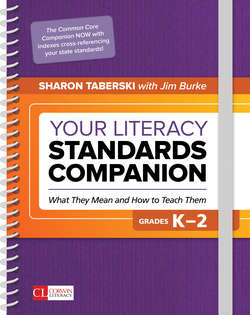Читать книгу Your Literacy Standards Companion, Grades K-2 - Jim Burke - Страница 47
На сайте Литреса книга снята с продажи.
Grades K–2 Common Core Reading Standard 3: Academic Vocabulary: Key Words and Phrases
ОглавлениеAnalyze: This means to look closely at something for the key parts and how they work together.
Characters: Characters can be simple (flat, static) or complex (round, dynamic); only characters that change, that have rich inner lives and interact with people and their environments, can be considered “complex.”
Cause/effect relationship: This is the relationship between the reason (or “why”) something happens and the consequences of that action. The cause is why something happens. The effect is what happens as a result of the cause.
Compare/contrast: This requires students to identify and analyze what is similar (compare) and what is different (contrast) about two things.
Connections: This refers to how one idea, event, piece of information, or character interacts with or relates to another idea, event, piece of information, or character. When connecting one idea to another idea or one event to another event, students often have to consider cause and effect, or why things turned out as they did. When connecting characters, they might need to consider how the changes in characters from the beginning of a story to the end relate to how the main character interacts with or relates to other characters or events in the story.
Develop and interact: As stories unfold, events and characters change; these changes are the consequences of interactions that take place between people, events, and ideas within a story or an actual social event. In addition, as individuals, events, and ideas change or develop, they often grow more complex or evolve into something altogether different.
Key details: In the context of literature, key details relate to story grammar elements—that is, character, setting, problem, major events, and resolution—and how they interact. In the context of informational text, key details refer to the facts and ideas the author selects to support the text’s main idea.
Major events: These are the most important events in a story, typically related to how the main character resolves a problem or handles a challenge.
Sequence of events: This is the order in which the events in a story or text occur, or the order in which specific tasks are performed.
Setting: This is the place and time in which a story, novel, or drama takes place. To determine the setting, students describe where it takes place (there may be more than one setting in a text) and when it takes place, which may refer to a specific time period or can be the past, present, or future.
Steps in technical procedures: Whether in social studies or science, the idea here is that in any series of steps or stages, some steps or stages are more crucial than others. Students must be able to discern this so they can understand why the steps or stages are so important and how they affect other people or events.
